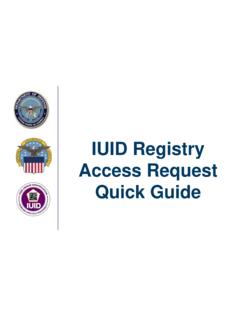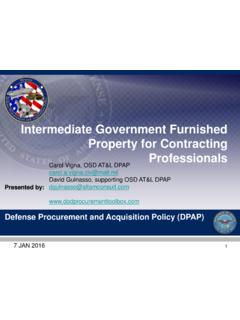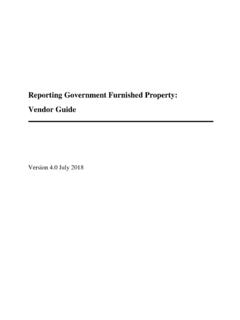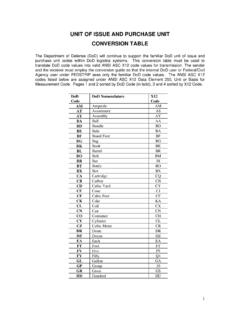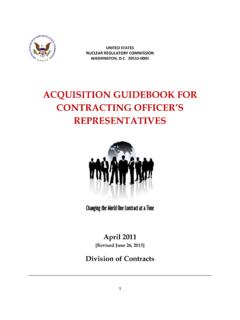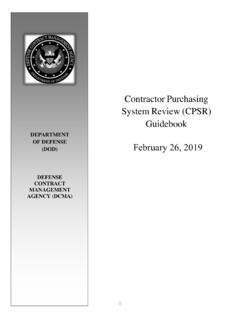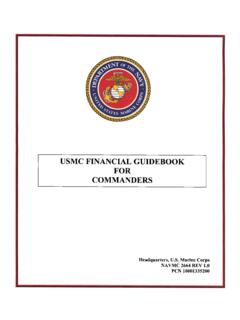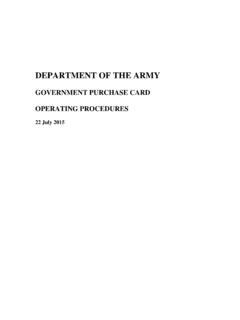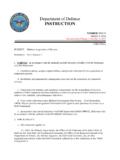Transcription of Contract Closeout Guidebook 20191025 Final
1 Contract Closeout Guidebook Version as of October 25th, 2019 Contract Closeout Guidebook October 2019 2 Table of Contents Table of Contents .. 2 1 Purpose .. 3 2 Preface .. 3 3 The Contract Closeout Process .. 4 When Does the Contract Closeout Process Begin? .. 4 Types of Closeout .. 6 Automated Contract Closeout .. 6 Manual Contract Closeout .. 8 A. Procedures for Manual Contract Closeout .. 9 Time Standards for Contract Closeout .. 14 File Retention Period .. 15 Responsibility for Contract Closeout .. 15 Responsibility of the Procuring Office When Administrative Contract Closeout is Performed by a Different Office .. 15 Contract Closeout Reporting .. 16 4 Appendices .. 17 Appendix A Acronyms .. 17 Appendix B Problems in Contract Closeout .. 19 Appendix C DoD Class Deviation 2019-Quick Closeout Procedures Threshold.
2 25 Appendix D contracting officer s Documentation for Using Quick Closeout Authority .. 26 Appendix E Forms .. 28 DD Form 254 (April 2018).. 28 DD Form 882 (July 2005) .. 28 DD Form 1593 (April 1969) .. 28 DD Form 1594 (February 1970) .. 28 DD Form 1597 (April 2000) .. 28 Appendix F Sample Release of Claims and Assignment of Refunds, Rebates, and Credits .. 29 Appendix G Chart of FAR/DFARS/PGI Closeout References .. 31 Appendix H PIEE Closeout Tool Roles, Workflow, and Reports .. 32 Appendix I AbilityOne Program .. 34 Appendix J PIEE Closeout Reports .. 36 Contract Closeout Guidebook October 2019 3 1 Purpose The purpose of this Guidebook is to help Department of Defense (DoD) officials establish and manage Contract Closeout . It provides an inventory of the pertinent polices and processes, with a goal of streamlining and consolidating guidance on Contract Closeout in a single easy-to-access document.
3 2 Preface Contract Closeout is the Final action taken on each DoD acquisition and establishes that each party has fully satisfied its obligation to the other. The contractor must have delivered everything the Contract required (material, services, data, certifications, etc.) and the Government must have paid the contractor in full. Any excess funds on the Contract must have been de-obligated. Property rights, both physical and intellectual, must have been settled to the satisfaction of the parties. Administrative actions must have been finalized, all necessary documentation must have been included in the Contract file, and a Contract Completion Statement must have been generated. These Contract Closeout requirements can be found in Figure 1 below: Figure 1 Timely Contract Closeout is important because without this Final step in a Contract s life cycle, the Government cannot settle its financial records.
4 Unliquidated balances, the funds remaining on a Contract after performance has ended, can result in not identifying improper payments in a timely manner, or in the inability to reuse excess unspent funds elsewhere. Even though Contract Closeout is important, it is often given a low priority by most contracting activities because efforts are focused on new Contract awards so that end users can receive the goods and services needed to meet mission requirements. As a result, Contract Closeout is generally seen as an organizational weakness and often the subject of audit investigations and reports within the Department. The Closeout process can be simple or complex depending on the Contract type. Contract Closeout may require coordination between the procuring contracting office, payment office, field administration office, program office, auditing office, security office, general council, and Requirements for Contract CloseoutAll parties have fully satisfied obligations to the other(s).
5 All Contract requirements have been has paid contractor in excess funds on the Contract have been rights have been settled to the satisfaction of all actions have been documentation has been included in the Completion Statement has been Closeout Guidebook October 2019 4 the contractor. Proper Contract construction, thorough Contract and modification receipt and review, and timely monitoring of funds status and potential for cancellation of funds, leads to an easier and more efficient Contract Closeout process. Figure 2 includes the primary personnel and offices that play a role in the Contract Closeout process: Figure 2 The purpose of this Contract Closeout Guidebook is to assist contracting Officers with this important effort. The Guidebook takes policy from across the Federal Acquisition Regulation (FAR), Defense Federal Acquisition Regulation Supplement (DFARS), Procedures, Guidance, and Information (PGI), and Financial Management Regulation (FMR) and places it in a single reference.
6 It does not address component specific policies and procedures for Contract Closeout . 3 The Contract Closeout Process When Does the Contract Closeout Process Begin? The office administering the Contract is responsible for initiating administrative Closeout after receiving evidence of physical completion. Physical completion is defined in FAR as: The contractor has completed the required deliveries and the Government has inspected and accepted the supplies; The contractor has performed all services and the Government has accepted these services; and all option provisions, if any, have expired; OR The Government has given the contractor a notice of complete Contract termination. Contract CloseoutContracting OfficeFinance OfficeProgram OfficeAuditing OfficeSecurity OfficeContractorContract Closeout Guidebook October 2019 5 Under Cost-Type or Time & Material (T&M)/Labor Hour (LH) contracts, , if the Government does not intend to provide additional money to the Contract , because of the terms of the Limitation of Cost/ Limitation of Funds and Payments under the T&M and LH Contracts clauses, which specify that the contractor does not have to continue performance once its costs equal the established cost ceiling of the Contract , the contractor does not have to deliver the required supplies.
7 Thus, under these types of contracts that Contract should be considered physically complete once the cost ceiling is reached. Although a Contract may be physically complete, other factors may delay the actual Closeout . For example, if the Final amount due to the contractor has not been determined or if there is an outstanding claim by or against the contractor, the Contract may not be closed even if it is physically complete. Based on these considerations, a Contract may not be closed until it is physically complete, the amount owed to the contractor has been finally determined, and all claims regarding the Contract have been resolved. Contracts are administratively complete when all administrative activities have been accomplished, any required releases executed, and Final payments made. Figure 3 Closeout of Basic IDC/BOA/BPA: When the ordering period in the basic Indefinite Delivery- Contract (IDC), Basic Ordering Agreement (BOA), or Blanket Purchase Agreement (BPA) has lapsed, and no modification has been issued to extend the ordering period, the basic IDC, BOA, or BPA can be closed only when all orders issued against it have been closed.
8 Contract Closeout of individual orders under IDC, BOA, or BPA s should begin once the order is physically complete. Continued Contract : PGI allows for a continued Contract to be issued solely for administrative reasons. The predecessor Contract should be closed out when all inspection, acceptance, payment, and other Closeout issues associated with supplies delivered and services performed under the predecessor Contract are complete. Note: Facilities contracts, rental, use, and storage agreements are considered to be physically complete when the Government has given the contractor a notice of complete Contract termination; or the Contract period has expired. A Contract should NOT be closed if:The Contract is in litigation or under appealThe Contract is under investigation or involves a deferred debtThe Contract has value engineering proposals pendingThe Contract is terminated and the termination actions have not been completedContract Closeout Guidebook October 2019 6 Types of Closeout Automated Contract Closeout As permitted by FAR (a), Automated Contract Closeout (ACCO) allows a system to initiate and execute the Closeout action without action on the part of the contracting officer administering the Contract .
9 ACCO is a capability that currently resides in PIEE. A Contract qualifies for the ACCO process if it meets the criteria in Figure 5 below, which is outlined in DFARS PGI : DFARS PGI Requirements for Automated Contract Closeout Contract Type = Firm-fixed priced Contract Value does not exceed $500,000 (inclusive of exercised options) Contract does not contain any of the following provisions requiring administrative action at Closeout : (A) FAR Liquidated Damages Supplies, Services, or Research and Development. (B) FAR Allowable Cost and Payment. (C) FAR Refund of Royalties. (D) FAR Patent Rights Ownership by the Contractor. (E) FAR Patent Rights Ownership by the Government. (F) FAR Progress Payments. (G) FAR Terms for Financing of Purchases of Commercial Items. (H) FAR Installment Payments for Commercial Items.
10 (I) FAR Performance-Based Payments. (J) FAR Government Property. (K) FAR Value Engineering. Figure 5 Contract Closeout Guidebook October 2019 7 DFARS PGI also states that Components may apply additional conditions not listed in Figure 5 above, as necessary to ensure all Contract requirements have been completed prior to Closeout . The additional requirements for a Contract to qualify for ACCO are listed in Figure 6 below: Additional Automated Contract Closeout Requirements All shipments for the Contract must be in a processed or extracted status in Wide Area Work-Flow (WAWF) A Final invoice must have been submitted in WAWF A Paid status must be present in WAWF (sourced from MyInvoice data) Contract does not contain any of the following provisions: FAR Incentive Price Revision Firm Target FAR Incentive Price Revision Successive Targets FAR Small Business Subcontracting Plan DFARS Patents reporting of subject inventions Contracts, orders, and all subsequent modifications must be present in EDA in Procurement Data Standard (PDS) compliant status if a Contract Writing System (CWS) was used to generate to Contract action.
